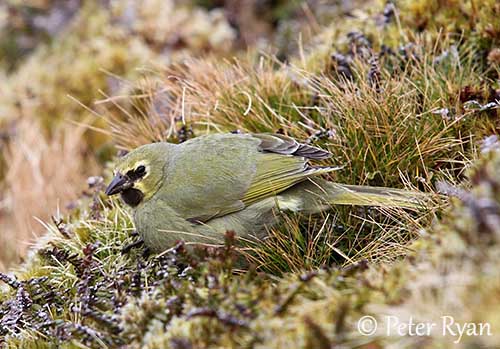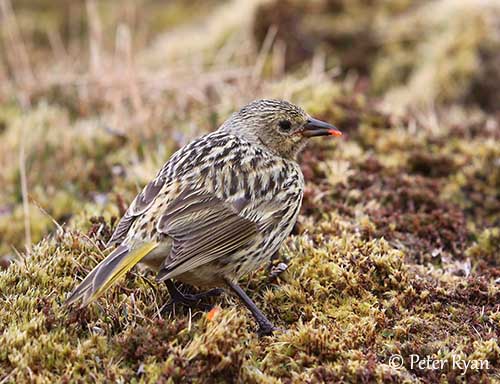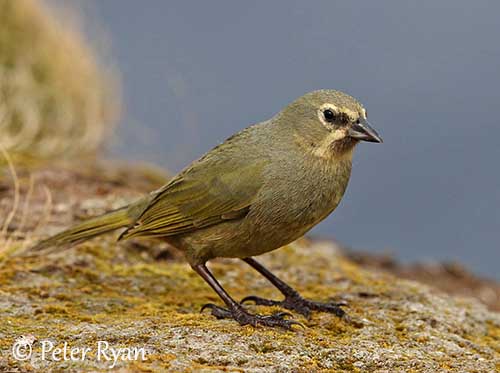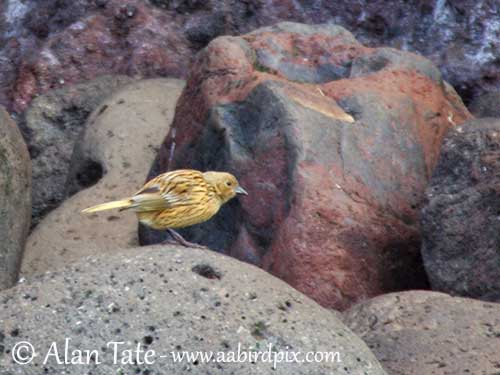
Fr: Rowettie de Gough
Ang: Gough Finch
All: Goughammerfink
Esp: Yal de Gough
Ita: Fringuello dell'Isola Gough
Nd: Goughgors
Sd: Goughfink
Photographer:
Peter Ryan (Many thanks for his special contribution to this page)
The Percy Fitzpatrick Institute of African Ornithology
Alan & Ann Tate
AA Bird Photography
Text by Nicole Bouglouan
Sources:
HANDBOOK OF THE BIRDS OF THE WORLD Vol 16 by Josep del Hoyo- Andrew Elliot-David Christie – Lynx Edicions – ISBN: 9788496553781
Molecular Phylogenetics and Evolution – The origin of finches on Tristan da Cunha and Gough island, central South Atlantic Ocean
Peter G. Ryan, Luke B. Klicka, Keith F. Barker, Kevin J. Burns
BirdLife International (BirdLife International)
Red List of Threatened species
Gough Island 58
Our year on a small uninhabited island in the remote South Atlantic
SANAP - South African National Antarctic Programme
Wikipedia, the free encyclopaedia
Gough Finch
Rowettia goughensis
Passeriformes Order – Thraupidae Family
INTRODUCTION:
The Gough Finch is endemic to the remote Gough Island in South Atlantic Ocean, where it is the only passerine.
This Critically Endangered species shows close physical similarities with the two Melanodera finches from S South America and Falkland Islands. The three species have black facial mask and bib, but only the males in Melanodera, and both male and female in Rowettia goughensis. However, juvenile and immature plumages in Rowettia are similar to that of the female Melanodera. This relationship was confirmed by genetic study.
See the page: White-bridled Finch
The Gough Finch is threatened by the introduced House Mouse (Mus musculus) in lowland where nest predation is heavy, involving the decline of the population. Mouse predation is more reduced in upland habitat, steep slopes, cliffs and offshore stacks where the Gough Finch is nesting too, making it rare at lower elevations.
Future measures are waiting for approval by the RSPB's Council, in order to eradicate this mouse, but both mountainous terrain and numerous caves make complicated attempts. The bait pellets will be spread by helicopter across the island by 2017 or 2018. The goal is simple: to make Gough Island predator-free and the Gough Finch’s population will be able to recover, like the other threatened bird species.
DESCRIPTION OF THE BIRD:
Biometrics:
Length: 23-26 cm
Weight: 50-56 g
The Gough Finch is one of the largest members of the family Thraupidae.
The adult male has olive-green plumage overall, with dark olive-brown flight feathers showing yellowish outer edges. The tail is similar, with yellowish-edged outer rectrices.
The underparts are greenish on breast, and more yellowish on belly.
On the head, black facial mask and bib are enhanced by pale yellowish supercilium, partially broken eyering and submoustachial area.
The thick-based bill is black. The eyes are dark brown. Legs and feet are dark grey.

CALLS AND SONGS:
The Gough Finch’s contact call is a soft “keet keet” whereas the alarm call is louder. It is given with head and bill pointed upwards while the bird is standing-erect. This call is usually given when the Brown Skua is flying above their territory.
The advertising call by male is a high-pitched “tsweeeep”, while the female utters a deep chattering call. Both mates often duet.
BEHAVIOUR IN THE WILD:
The Gough Finch spends most of its time (about 80%) in searching for invertebrates. Its diet includes numerous insects and spiders. However, it also consumes seeds of sedges (Carex, Scirpus and Uncinia) and several species of grass, including Poa annua. Berries of Nertera depressa are also eaten.
It may scavenge broken eggs and carrion. Like the Tristan Thrush, it also enters seabird burrows.
It forages among moss and loose vegetation. It pulls up the vegetation with the bill or the feet to find its preys, or tears apart rotten wood, and occasionally hawks flying insects.

During the breeding season, both mates defend the breeding territory. The male is very territorial, and remains close to the female during the egg-laying. They are monogamous.
Information about the courtship displays is missing, but we can suggest that the striking head pattern is enhanced by adapted postures, accompanied by vocalizes.
The Gough Finch is resident within its restricted range on Gough Island, and only performs short movements of less than two kilometres.
REPRODUCTION OF THIS SPECIES:
The breeding season occurs between September and December, with peak in October/November. It may occur earlier at lower elevations.
The female builds the nest, a deep cup-shaped structure made with long grass and sedge leaves, and lined with softer vegetation. The nest-materials are collected in the vicinity of the nest-site, often located on steep slope or cliff. The nest is placed on or near the ground, usually among dense vegetation, and sheltered by rock or hanging plants.
The female lays 1-3, usually 2 pale blue eggs with dark brown speckles. A replacement clutch is laid if the first fails.
She incubates alone (the duration of this period is unknown) and she is regularly fed by the male near the nest, every 20/25 minutes. She utters a distinctive soft call while begging for food. She may leave the nest 5-10 minutes for foraging.
The female broods the chicks and feeds them with the food provided by the male. The young leave the nest about 20-26 days after hatching, and they remain hidden in the dense cover around the nest. Then, they follow their parents for foraging.
With the decline of the population, individuals in immature, and even in juvenile plumage, can be included in pairs. But breeding by juveniles needs yet to be confirmed.

PROTECTION / THREATS / STATUS:
The Gough Finch is affected by excessive predation by introduced mice in lowland, involving the decline of the population in these areas. The proportion of juveniles has declined from 50% to 20% over the last 15 years.
Eradication of mice is a future action waiting for approval, using the experience gained from the same eradication project on Macquarie Island.
The population of the Gough Finch was estimated at 1000 individuals in 2007, equating to about 670 mature individuals. Numbers are decreasing. For these reasons, with in addition a restricted range, the Gough Finch is listed as Critically Endangered.
The female is slightly smaller than the male. She is duller with mostly brownish facial mask, pale buffy-olive upper breast and greyer upperparts.
The juvenile retains its plumage for the first year. It has sandy-buff plumage with dark brown to blackish streaking on head, back and underparts. The rump is buff and less streaked. The flight feathers and the outer rectrices are edged yellow. The facial pattern is absent.
The immature resembles adult female, but the facial pattern is indistinct, and the feathers still have some blackish-brown streaking. The rump is tinged buff. However, the young male has more conspicuous dark facial pattern than the immature female. They need at least 2-3 years to acquire the full adult plumage.
RANGE:
The Gough Finch occurs on Gough Island and on vegetated offshore stacks in South Atlantic Ocean.
HABITAT:
The Gough Finch can be found in a variety of habitats. It frequents the boulder beaches, but it can be seen on high mountain peaks up to 900 metres of elevation, although it is mainly present in upland above 300 metres, in tussock grassland and wet heath. This species is now rare at lower elevation.
